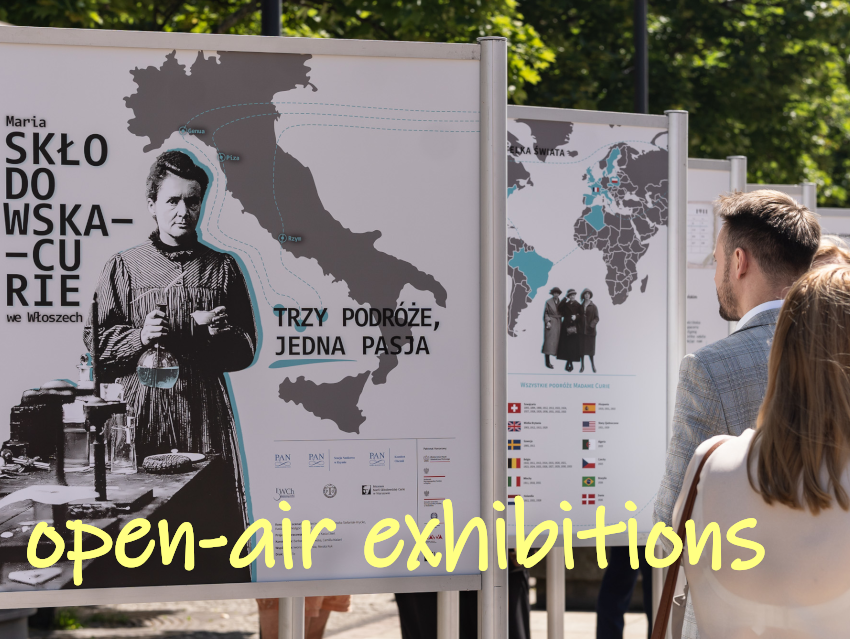Just in time for summer and the holiday season, open-air exhibitions about Marie Skłodowska-Curie are now on display in Poland and Italy. If you are attending a conference or are on vacation in Warsaw or Genoa, do not miss the chance to visit. Dates and exact locations are listed below.
Marie Skłodowska-Curie’s Journeys to Italy
One of the lesser-known facts about Marie Curie—who received the Nobel Prize in Chemistry in 1911, awarded solely to her for the discovery of the elements polonium and radium, and for her investigation of their properties, and in Physics in 1903, shared with Pierre Curie and Henri Becquerel for their work on radioactivity—is her travels through Italy in 1911, 1918, and 1931.
Maria Skłodowska-Curie first visited Italy in spring 1911, combining work and leisure. After lecturing on radium at a scientific conference at the University of Genoa, she toured northern Italy with her daughters and friends—the Borels, Émile Borel, a French mathematician and politician, and his wife Marguerite—enjoying Liguria and Lake Maggiore. This took place shortly before she received her second Nobel Prize.
Her second stay in Italy was driven by her need to find new sources of radium for medical and scientific purposes, particularly due to shortages in France caused by World War I [2]. She traveled extensively throughout Tuscany, southern and northern Italy, visiting several locations known for their thermal springs and mineral deposits, including Pisa, Tuscany, the island of Ischia, and Montecatini. During her visit, she collaborated with prominent Italian scientists like Professor Rafaelo Nasini and his assistant, Camilo Porlezza from the University of Pisa.
Marie Curie’s research trip helped establish Italy’s National Commission for Radioactive Substances in 1919 and strengthened scientific ties between Italy and France. It also advanced practical uses of radioactivity, particularly medical uses and highlighted the value of international cooperation in science.
Her third visit to Italy was in 1931, when she participated in an international scientific conference in Rome organized by Enrico Fermi [3].
Official Opening of the Exhibitions
The official opening of the outdoor exhibitions titled “Maria Skłodowska-Curie in Italy: Three Journeys” took place on July 4, 2025, at Krakowskie Przedmieście 66 in Warsaw, Poland. The date marks the 91st anniversary of Maria Skłodowska-Curie’s death. The building is where, at the end of the 19th century, the 23-year-old Maria took a course in analytical chemistry, thanks to the generosity of her cousin, Józef Boguski. This course laid the foundation for her future discoveries in Paris. As she later recalled, “If I had not been well taught chemical analysis in Warsaw (…), I would not have isolated radium.”
During the opening speeches, Professor Marcin Górecki of the Institute of Organic Chemistry, Polish Academy of Sciences (PAS), Warsaw, and Agnieszka Stefaniak-Hrycko, Director of the PAS Scientific Center in Rome, Italy, noted that Madame Curie’s visits to Italy “played a crucial role in the development of radioactivity research in Italy. They were not only scientific expeditions but also opportunities to establish international scientific collaborations, which soon led to the creation of the renowned group led by Enrico Fermi at the University of Rome – La Sapienza (in 1926).”
Exhibition guests could also visit the Maria Skłodowska-Curie Museum at 16 Freta Street, Warsaw, where they explored the temporary exhibition titled “Who Are You, Maria?” or „Kim jesteś, Mario?” in Polish.
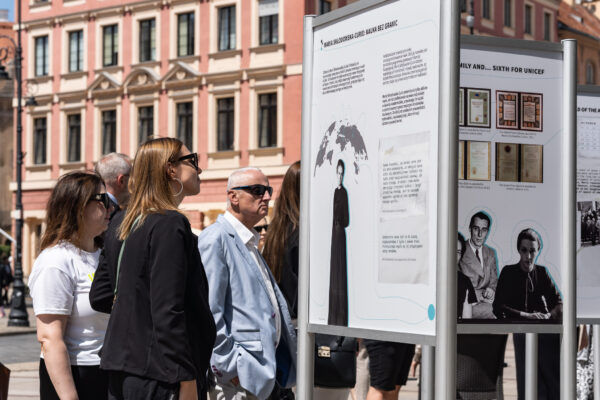
Figure 1. Snapshots of the exhibition. Photos © Polish Academy of Sciences (PAS)
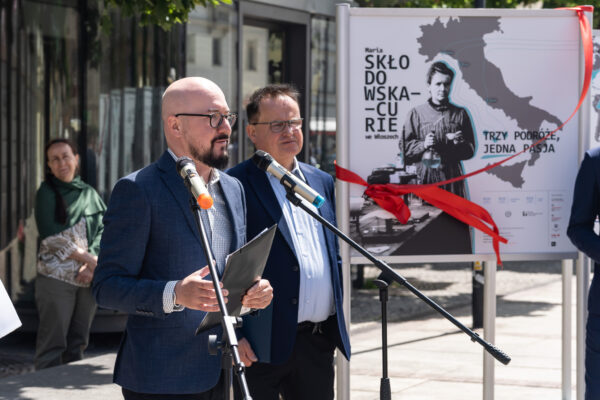
Figure 2. Professor Marcin Górecki, Polish Academy of Sciences (PAS), Warsaw, and Professor Paweł Kulesza, Chair of the Committee of Chemistry, PAS, University of Warsaw. Photo © Polish Academy of Sciences (PAS)
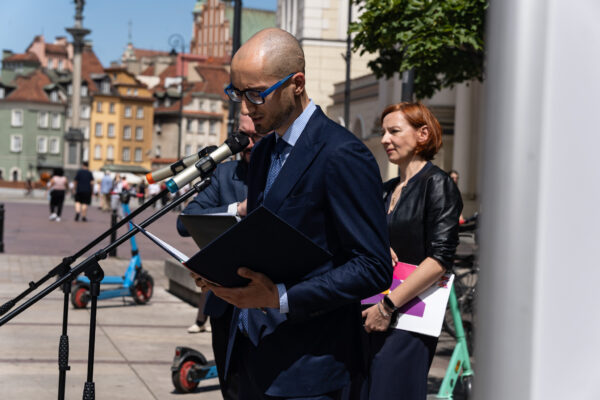
Figure 3. Vincenzo Spinelli, Ambasy of Italy in Poland, during the opening ceremony. Photo © Polish Academy of Sciences (PAS)
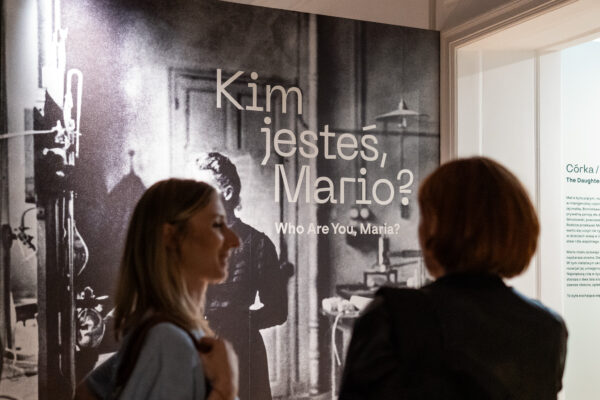
Figure 4. Temporary exhibition “Who Are You, Maria?” or „Kim jesteś, Mario?” in Polish at the Maria Skłodowska-Curie Museum [4]. Photo © Polish Academy of Sciences (PAS)
The event was organized by the Committee on Chemistry of the Polish Academy of Sciences (PAS), the PAS Scientific Center in Rome, the Faculty of Chemistry at the University of Warsaw, the Polish Chemical Society, and Maria Skłodowska-Curie Museum in Warsaw. The project received funding under the PAS “Open Science” program. It is held under the honorary patronage of the Minister of Science and Higher Education, the Embassy of Italy in Warsaw, the Embassy of the Republic of Poland in Rome, the Consulate General of the Republic of Poland in Milan, the Polish National Agency for Academic Exchange (NAWA), and the Musée Curie in Paris.
Exhibition Dates
Warsaw, Poland
July 4 – August 17, 2025
Krakowskie Przedmieście 66
September 22 – 26, 2025
during the Annual Meeting of the Polish Chemical Society
Genoa, Italy
September 8 – October 11, 2025
Indoor exhibition at Biblioteca Civica Berio, Via del Seminario 16
Opening on September 8, during the XLV National Congress of the Italian Society for the History of Physics and Astronomy
The exhibition can be visited during the library’s opening hours; admission is free.
Rome, Italy
September 26 – 27, 2025
During the Researchers’ Night
Bari, Italy
October 14, 2025, 5:00 PM
University of Bari – Hall of Centro Polifunzionale Studenti (Ex Poste), Piazza Cesare Battisti 1, as part of the 9th Polish–Italian Culture Week
Syracuse, Sicily, Italy
November 29, 2025, 5:00 PM
Ipogeo di Piazza Duomo
Paris, France
coming soon
Sources and References
[1] Inauguracja wystawy pt. „Maria Skłodowska-Curie we Włoszech: trzy podróże, jedna pasja”, Polish Academy of Sciences (PAN) website (accessed July 23, 2025)
[2] Polska Akademia Nauk (PAS), Marie Skłodowska-Curie in Italy in search of radium, YouTube 2023. (accessed July 23, 2025)
[3] Archivio Luce Cinecittà, A Roma congresso internazionale di fisica nucleare, YouTube 2012. (accessed July 23, 2025)
[4] Maria Skłodowska-Curie Museum in Warsaw, Poland
Also of Interest

The first Polish and English critical edition, essential for science history enthusiasts and those interested in women in science and remarkable lives of individuals who have shaped our world

The Marie Curie pavillon has been saved from demolition, but are the new plans a final decision? Many hope not

Documentary film describes a little-known three-week stay in Italy to find new sources of radium

Every day until December 24 we will unlock a new destination for your bucket list—join our chemistry Europe trip
